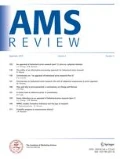Abstract
This paper builds upon Zaltman’s call for greater imagination in theory and practice by exploring the role of imagination in building and applying good theories. It begins by juxtaposing everyday associations to the concept of imagination with scientists’ goal of developing theories that are objectively grounded in data. In research, imagination must focus on explaining why an effect may have occurred. Then, the practical value of such theorizing is explored. It is argued that good theories, though imagined, should to be viewed as real in that they offer a valuable viewpoint for solving practical problems. They expand the real world of the practitioner rather than existing in some ivory tower outside that world. A different sort of imagination, however, is required to move from an abstract theory to an intervention that can be implemented in the real world. Good theory can be highly practical but it requires separating research designed to build and test theory from research designed to evaluate the efficacy of theory-inspired interventions to real world problems.

Similar content being viewed by others
References
Alba, J. W. (2012). In defense of bumbling. Journal of Consumer Research, 38(6), 981–987.
Bem, D. (1972). Self-perception theory. In L. Berkowitz (Ed), Advances in experimental social psychology, volume 6, 1-62.
Biswas, D., Szocs, C., Wansink, B., & Chacko, R. (2016). Shining light on atmospherics: How ambient light influences food choices. Journal of Marketing Research, April, Retrieved July 18, 2016 from https://www.researchgate.net/publication/299823750_Shining_Light_on_Atmospherics_How_Ambient_Light_Influences_Food_Choices.
Bradford, A. (2015). What is a scientific theory? Retrieved July 18, 2016 from http://www.livescience.com/21491-what-is-a-scientific-theory-definition-of-theory.htm.
Calder, B. J., & Tybout, A. M. (1999). A vision of theory, research and the future of business schools. Journal of the Academy of Marketing Science, 27(3), 359–366.
Calder, B. J., Phillips, L. W., & Tybout, A. M. (1981). Designing research for application. Journal of Consumer Research, 8(2), 197–207.
Calder, B. J., Phillips, L. W., & Tybout, A. M. (1982). The concept of external validity. Journal of Consumer Research, 9(3), 240–244.
Calder, B. J., Phillips, L. W., & Tybout, A. M. (1983). Beyond external validity. Journal of Consumer Research, 10(1), 112–114.
Deutsch, D. (2011). The beginning of infinity: Explanations that transform the world. New York: Viking.
Fara, P. (2015). That the apple fell and Newton invented the law of gravity, thus removing God from the universe. In R. L. Numbers & K. Kampourakis (Eds.), Newton’s Apple (pp. 48–56). Cambridge: Harvard University Press.
Firestone, S. (2012). Ignorance: How it drives science. Oxford: Oxford University Press.
Freedman, J. L., & Fraser, S. C. (1966). Compliance without pressure: the foot-in-the-door technique. Journal of personality and social psychology, 4(2), 195.
Green, M. C., & Brock, T. C. (2000). The role of transportation in the persuasiveness of public narrative. Journal of Personality and Social Psychology, 79(5), 701–721.
Greene, B. (1978). Worms? McDonald’s isn’t laughing. Chicago Tribune, Nov 20, A1.
Lipton, P. (2004). Inference to the best explanation. London: Routledge.
Lynch, J. G., Jr. (1982). On the external validity of experiments in consumer research. Journal of Consumer Research, 9(3), 225–239.
Lynch, J. G., Alba, J. A., Krishna, A., Morwitz, V., & Gürhan Canali, Z. (2012). Knowledge creation in consumer research: multiple routes, multiple criteria. Journal of Consumer Psychology, 22, 473–485.
Merriam-Webster Dictionary (2016). Retrieved July 18, 2016, http://www.merriam-webster.com/dictionary/theory.
Popper, K. (1994). Knowledge and the body-mind problem: In defense of interaction. London: Routledge.
Thomas, N. J. T. (2004). Retrieved July 18, 2016, https://sites.google.com/site/minddict/imagination.
Tybout, A. M., Calder, B. J., & Sternthal, B. (1981). Using information processing theory to design marketing strategies. Journal of Marketing Research, 18(2), 73–79.
Tybout, A. M., Sternthal, B., & Calder, B. J. (1983). Information availability as a determinant of multiple request effectiveness. Journal of Marketing Research, 8(1), 280–290.
Wang, J., & Calder, B. J. (2006). Media transportation and advertising. Journal of Consumer Behavior, 33(2), 151–162.
Wang, J., & Calder, B. J. (2009). Media engagement and advertising: transportation, matching, transference, and intrusion. Journal of Consumer Psychology, 19(3), 546–555.
Zaltman, G. (2016). Marketing’s forthcoming age of imagination. AMS Review. doi: 10.1007/s13162-016-0082-3.
Author information
Authors and Affiliations
Corresponding author
Rights and permissions
About this article
Cite this article
Calder, B.J., Tybout, A.M. What makes a good theory practical?. AMS Rev 6, 116–124 (2016). https://doi.org/10.1007/s13162-016-0084-1
Received:
Accepted:
Published:
Issue Date:
DOI: https://doi.org/10.1007/s13162-016-0084-1




